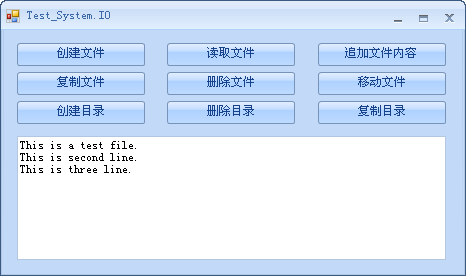转载自:http://www.cnblogs.com/SkySoot/archive/2012/03/12/2391704.html
运行效果:

代码:
1 /// <summary> 2 /// 文件读写操作 3 /// 为简化代码供大家学习,暂不考虑捕捉异常 4 /// </summary> 5 public partial class TestIO : DevComponents.DotNetBar.Office2007Form 6 { 7 public TestIO() 8 { 9 InitializeComponent(); 10 } 11 12 /// <summary> 13 /// 创建文件 14 /// </summary> 15 private void btnCreateFile_Click(object sender, EventArgs e) 16 { 17 string path = Application.StartupPath + @"Test.txt"; 18 FileStream fs = new FileStream(path, FileMode.Create); 19 StreamWriter sw = new StreamWriter(fs); 20 sw.WriteLine("This is a test file."); 21 sw.WriteLine("This is second line."); 22 sw.Close(); 23 fs.Close(); 24 25 // 也可以这样创建 StreamWriter 26 // StreamWriter sw = File.CreateText(path); 27 } 28 29 /// <summary> 30 /// 读取文件 31 /// </summary> 32 private void btnReadFile_Click(object sender, EventArgs e) 33 { 34 string path = Application.StartupPath + "\Test.txt"; 35 textBoxX1.Text = string.Empty; 36 if (File.Exists(path)) 37 { 38 FileStream fs = new FileStream(path, FileMode.Open); 39 StreamReader sr = new StreamReader(fs); 40 // 也可以这样创建 StreamReader 41 // File.OpenText(path); 42 string str = string.Empty; 43 while (true) 44 { 45 str = sr.ReadLine(); 46 if (!string.IsNullOrEmpty(str)) 47 { 48 textBoxX1.Text += str + " "; 49 } 50 else 51 { 52 sr.Close(); 53 fs.Close(); 54 break; 55 } 56 } 57 } 58 else 59 { 60 MessageBox.Show("指定的路径下不存在此文件!"); 61 } 62 } 63 64 /// <summary> 65 /// 追加文件内容 66 /// </summary> 67 private void btnAppendFile_Click(object sender, EventArgs e) 68 { 69 string path = Application.StartupPath + "\Test.txt"; 70 FileStream fs = new FileStream(path, FileMode.Append); 71 StreamWriter sw = new StreamWriter(fs); 72 // 也可以这样创建 StreamReader 73 // StreamWriter sw = File.AppendText(path); 74 sw.WriteLine("This is three line."); 75 sw.Close(); 76 fs.Close(); 77 } 78 79 /// <summary> 80 /// 复制文件 81 /// </summary> 82 private void btnCopyFile_Click(object sender, EventArgs e) 83 { 84 string oldPath = Application.StartupPath + "\Test.txt"; 85 string newPath = Application.StartupPath + "\TestClone.txt"; 86 File.Copy(oldPath, newPath); 87 } 88 89 /// <summary> 90 /// 删除文件 91 /// </summary> 92 private void btnDeleteFile_Click(object sender, EventArgs e) 93 { 94 string path = Application.StartupPath + "\TestClone.txt"; 95 File.Delete(path); 96 } 97 98 99 /// <summary> 100 /// 移动文件 101 /// </summary> 102 private void btnMoveFile_Click(object sender, EventArgs e) 103 { 104 string oldPath = Application.StartupPath + "\Test.txt"; 105 // 移动文件的同时也可以使用新的文件名 106 string newPath = "d:\NewTest.txt"; 107 File.Move(oldPath, newPath); 108 } 109 110 /// <summary> 111 /// 创建目录 112 /// </summary> 113 private void btnCreateDirectory_Click(object sender, EventArgs e) 114 { 115 string path1 = "d:\Jason1"; 116 // 创建目录 Jason1 117 DirectoryInfo dDepth1 = Directory.CreateDirectory(path1); 118 // dDepth2 指向 dDepth1 创建的子目录 Jason2 119 DirectoryInfo dDepth2 = dDepth1.CreateSubdirectory("Jason2"); 120 // 设置应用程序当前的工作目录为 dDepth2 指向的目录 121 Directory.SetCurrentDirectory(dDepth2.FullName); 122 // 在当前目录创建目录 Jason3 123 Directory.CreateDirectory("Jason3"); 124 } 125 126 private void btnDeleteDirectory_Click(object sender, EventArgs e) 127 { 128 string path = "d:\Jason1"; 129 DeleteDirectory(path); 130 } 131 132 /// <summary> 133 /// 删除目录及其所有子目录,文件 134 /// </summary> 135 private static void DeleteDirectory(string path) 136 { 137 if (Directory.Exists(path)) 138 { 139 foreach (string str in Directory.GetFileSystemEntries(path)) 140 { 141 if (File.Exists(str)) 142 { 143 File.Delete(str); 144 } 145 else 146 { 147 DeleteDirectory(str); 148 } 149 } 150 Directory.Delete(path); 151 } 152 else 153 { 154 MessageBox.Show("该目录不存在!"); 155 } 156 } 157 158 private void btnCopyDirectory_Click(object sender, EventArgs e) 159 { 160 string sourcePath = "d:\Jason1"; 161 string targetPath = "d:\Jason2"; 162 CopyDirectory(sourcePath, targetPath); 163 } 164 165 /// <summary> 166 /// 复制目录及其所有内容 167 /// </summary> 168 /// <param name="sourcePath">源目录</param> 169 /// <param name="targetPath">目标目录</param> 170 private void CopyDirectory(string sourcePath, string targetPath) 171 { 172 // 该字符用于在反映分层文件系统组织的路径字符串中分隔目录级别(msdn) 173 // 在windows系统下实质上是为目录路径加上"\" 174 if (targetPath[targetPath.Length - 1] != Path.DirectorySeparatorChar) 175 { 176 targetPath += Path.DirectorySeparatorChar; 177 } 178 // 目标目录不存在则创建之 179 if (!Directory.Exists(targetPath)) 180 { 181 Directory.CreateDirectory(targetPath); 182 } 183 // 获取文件系统(含目录和文件) 184 string[] fileList = Directory.GetFileSystemEntries(sourcePath); 185 foreach (string fileName in fileList) 186 { 187 if (Directory.Exists(fileName)) 188 { 189 // Path.GetFileName(fileName) 可取出最后一个分级目录名或文件名 190 CopyDirectory(fileName, targetPath + Path.GetFileName(fileName)); 191 } 192 else 193 { 194 // true 为可覆盖 195 File.Copy(fileName, targetPath + Path.GetFileName(fileName), true); 196 } 197 } 198 } 199 }